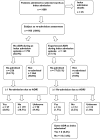Emergency re-admissions to hospital due to adverse drug reactions within 1 year of the index admission
- PMID: 21039769
- PMCID: PMC2997315
- DOI: 10.1111/j.1365-2125.2010.03751.x
Emergency re-admissions to hospital due to adverse drug reactions within 1 year of the index admission
Abstract
Aim: The proportion of re-admissions to hospital caused by ADRs is poorly documented in the UK. The aim of this study was to evaluate the impact of ADRs on re-admission to hospital after a period as an inpatient.
Methods: One thousand patients consecutively admitted to 12 wards were included. All subsequent admissions for this cohort within 1 year of discharge from the index admission were retrospectively reviewed.
Results: Of the 1000 patients included, 403 (40.3%, 95% CI 39.1, 45.4%) were re-admitted within 1 year. Complete data were available for 290 (70.2%) re-admitted patients, with an ADR contributing to admission in 60 (20.8%, 95% CI 16.4, 25.6%) patients. Presence of an ADR in the index admission did not predict for an ADR-related re-admission (10.5% vs. 7.2%, P=0.25), or re-admission overall (47.2% vs. 41.2%, P=0.15). The implicated drug was commenced in the index admission in 33/148 (22.3%) instances, with 37/148 (25%) commenced elsewhere since the index admission. Increasing age and an index admission in a medical ward were associated with a higher incidence of re-admission ADR. The most frequent causative drugs were anti-platelets and loop diuretics, with bleeding and renal impairment the most frequent ADRs. Over half (52/91, 57.1%) of the ADRs were judged to be definitely or possibly avoidable.
Conclusions: One fifth of patients re-admitted to hospital within 1 year of discharge from their index admission are re-admitted due to an ADR. Our data highlight drug and patient groups where interventions are needed to reduce the incidence of ADRs leading to re-admission.
© 2010 The Authors. British Journal of Clinical Pharmacology © 2010 The British Pharmacological Society.
Figures
Similar articles
-
Hospital re-admission associated with adverse drug reactions in patients over the age of 65 years.Eur J Clin Pharmacol. 2016 May;72(5):631-9. doi: 10.1007/s00228-016-2022-4. Epub 2016 Feb 17. Eur J Clin Pharmacol. 2016. PMID: 26884320
-
[Hospital readmission induced by adverse drug reaction: a pilot study in a post-emergency unit of a French university hospital].Rev Med Interne. 2015 Jul;36(7):450-6. doi: 10.1016/j.revmed.2014.11.016. Epub 2015 Jan 17. Rev Med Interne. 2015. PMID: 25604839 French.
-
The frequency of adverse drug reaction related admissions according to method of detection, admission urgency and medical department specialty.BMC Clin Pharmacol. 2009 May 4;9:8. doi: 10.1186/1472-6904-9-8. BMC Clin Pharmacol. 2009. PMID: 19409112 Free PMC article.
-
Prevalence, clinical features and avoidability of adverse drug reactions as cause of admission to a geriatric unit: a prospective study of 1756 patients.Drug Saf. 2008;31(6):545-56. doi: 10.2165/00002018-200831060-00009. Drug Saf. 2008. PMID: 18484788
-
Drug related hospital admissions in subspecialities of internal medicine.Dan Med Bull. 1996 Apr;43(2):141-55. Dan Med Bull. 1996. PMID: 8741207 Review.
Cited by
-
Systemic review on drug related hospital admissions - A pubmed based search.Saudi Pharm J. 2015 Jan;23(1):1-8. doi: 10.1016/j.jsps.2013.05.006. Epub 2013 May 30. Saudi Pharm J. 2015. PMID: 25685036 Free PMC article. Review.
-
Impact of medication reviews on drug-related problems (DRPs) in older patients living in nursing homes in West Occitania.Fundam Clin Pharmacol. 2023 Feb;37(1):182-190. doi: 10.1111/fcp.12820. Epub 2022 Aug 11. Fundam Clin Pharmacol. 2023. PMID: 35864740 Free PMC article.
-
Pharmacy professionals' views regarding the future of NHS patient medicines helpline services: a multimethod qualitative study.BMC Health Serv Res. 2021 Feb 12;21(1):137. doi: 10.1186/s12913-021-06144-6. BMC Health Serv Res. 2021. PMID: 33579266 Free PMC article.
-
Reducing Hepatocyte Injury and Necrosis in Response to Paracetamol Using Noncoding RNAs.Stem Cells Transl Med. 2016 Jun;5(6):764-72. doi: 10.5966/sctm.2015-0117. Epub 2016 Apr 7. Stem Cells Transl Med. 2016. PMID: 27057006 Free PMC article.
-
Databases in the area of pharmacogenetics.Hum Mutat. 2011 May;32(5):526-31. doi: 10.1002/humu.21454. Epub 2011 Apr 5. Hum Mutat. 2011. PMID: 21309040 Free PMC article. Review.
References
-
- Davies EC, Green CF, Taylor S, Williamson P, Mottram DR, Pirmohamed M. Adverse drug reactions in hospital in-patients: a prospective analysis of 3695 patient-episodes. PLoS ONE. 2009;4:e4439. doi: 10.1371/journal.pone.0004439. - DOI - PMC - PubMed
-
- Chapman J. 500 000 Hospital patients sent home too soon every year. Available at http://www.dailymail.co.uk/news/article-1247568/500-000-hospital-patient... (last accessed 12 February 2010.
-
- Dormann H, Neubert A, Criegee-Rieck M, Egger T, Radespeiel-Troger M, Azaz-Livshits T, Levy M, Brune K, Hahn EG. Readmissions and adverse drug reactions in internal medicine: the economic impact. Ann Intern Med. 2004;255:653–63. - PubMed
MeSH terms
LinkOut - more resources
Full Text Sources
Medical
Research Materials


